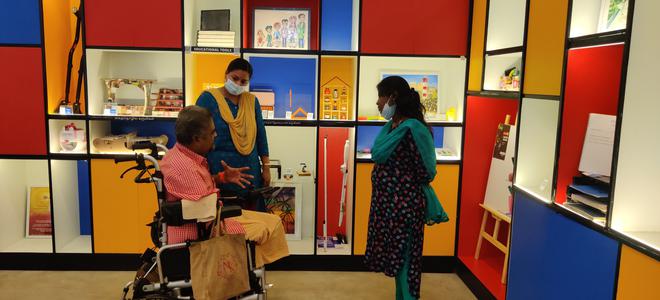There’s a lot to engage with and learn at the Museum of Possibilities at Kamarajar Salai by the Marina beach. Ahead of an event the space is playing host to, the interest of the visitors there is piqued by the various facets of a model accessible home — ranging from its adaptive cutlery, furniture, and even board games kept on display.
An initiative by the Department for the Welfare of the Differently Abled, the space is a demonstration centre for assistive devices and technology for persons with disabilities. The museum has been conceptualised to act as a bridge between the community of users and the innovators of such technology and devices.
“It is also a community hub for everyone interested in creating awareness about disability, Accessibility, Assistive Technology, and an Inclusive world,” says Hethal, the acting manager of the museum.
In a month after its inauguration in June, the museum has had over 400 visitors. “The response has been very good. The visitors include special educators, physiotherapists, persons with disabilities, their families and several others,” says Poonam Natarajan, Founder Vidyasagar.
The Team for Accessibility and Reasonable Accommodation (TARA), one of the pillars of Project Begin to Live Independently with Support Systems (BLISS) from Vidya Sagar, has worked on conceptualising the museum with the Tamil Nadu government.
Ms. Poonam recalls how among their first few visitors, was a man with muscular dystrophy, who came all the way from Tiruttani. “We spoke to him about his needs, and he was able to find assistive devices for his needs. We also put him in touch with the officials in his district for necessary rehabilitation measures. A few weeks ago, persons with multiple sclerosis come in to see the assistive technology and devices displayed here,” she explained.

A tactile map is placed near the entrance, and there is prominent signage as well as an indoor navigation app for visitors to use. The museum has mobile phones available, which visitors can use or download the mobile app. Every item on display has a QR code placed next to it, which visitors can scan and access details through various accessible formats ranging from text, image, audio description and sign language.
The Museum has adopted a domain specific model over a disability specific model, and has three domains — Live, Work, and Play.
One of the highlights of the museum under the ‘Live’ domain is the model accessible home. A living room, kitchen, bathroom and bedroom showcases universal design elements, assistive devices and technology. From tactile scrabble, to board games, and even adapted puzzles, there’s a lot to explore and experience in the Play domain which also includes hobbies and sports. Accessible and Assistive devices which can be used in workplaces are on display under the Work Domain. These include a Braille Slate with a stylus, a talking calculator, adapted colour keyboard, and a communication chart used as a part of Augmentative and Alternative Communication (AAC)
Apart from museum assistants, the MoP also has a physiotherapist and speech therapists who will support visitors both offline and online and guide them through what devices will be the best suited for them.

Vocational training centre and Museum Cafe
On top of the museum with a lovely view of a strip of the Marina Beach is a Cafe run by the Foundation for Vocational Training.
With the aim of training adults with disabilities and managing a quick service restaurant, the well-lit space has been designed as an inclusive and accessible one. A range of pictures and text chronicling the disability movement in India adorn one of its walls.
It is this space that welcomes a young innovator, 9 year old Aaryan Singh to speak about his invention — an obstacle detector he was inspired to build after his grandmother met with an accident owing to her poor eyesight.
“We are planning to have at least four such events every month on disability, assistive technology and accessibility,” Ms. Poonam says.







